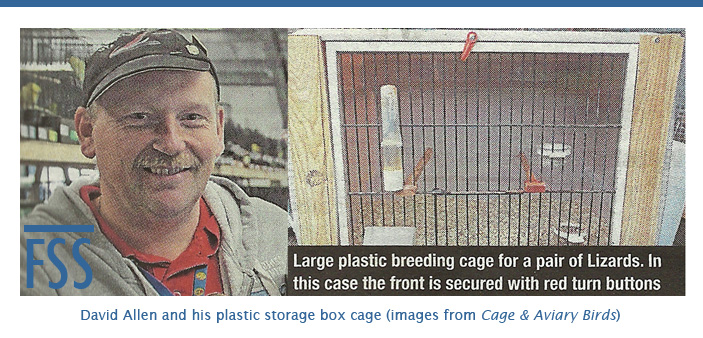Three articles in Cage & Aviary Birds caught my eye this week.
The first was entitled Thinking outside the box, but it is what goes inside the box that matters here. Author David Allen has come up with the brilliantly simple idea of converting a plastic storage box into a bird cage. You’ll have to read the article to see how he’s done it, but the image above shows you one of his prototypes.
Plastic cages are not a new idea, but most that I’ve seen have been brittle and became useless after a few essential components had snapped. They were also assembled by clipping panels together, and the joints became crevices for dirt and mite to hide.
The best I’ve seen were in Manolo Sueta’s birdroom. They were very robust and had the great advantage of being moulded in a single piece (apart from the cage front) so that there were no joints for dirt and mite to accumulate. Better still, all the internal corners were rounded so that the cage was very easy to clean. You’d think a cage like that would be a sure-fire commercial success, yet they’re no longer available and I’ve never seen them anywhere else.
David Allen has effectively reworked the concept of the one-piece plastic cage by using cheap plastic storage boxes. It’s a great idea but there are three challenges that need to be overcome. Firstly, they have to be adapted for use as a bird cage, not just the cage fronts but all the other accessories that are needed. Dave had trouble in fixing nest pans, seed hoppers etc. and is still trying out different ideas. The second is that these boxes are moulded so that they can be stacked easily, which means they are tapered rather than square in shape. The third, based on my experience of using such boxes for simple storage purposes, is that even if you find a storage box that suits your needs, it never seems to stay in production long. Go back a month or two later to buy some more and you will find that it is no longer available and that the newer model is a slightly different size, shape and colour. Doh!
You might think that this is a classic example of someone trying to re-invent the wheel. The wooden box cage, economic and available in any size or configuration you like, seems to have gone out of fashion. All-wire cages have their advantages, and Dave himself was a big advocate of them not so long ago, but we can only infer that they haven’t fulfilled his expectations. I’ve also seen some continental cages that use a composite construction of Trespa panels fixed to aluminium framing. Handsome looks, nothing to warp, rust or rot, but they have a fundamental fault: all the joints between the various components would make an ideal home for dirt and mite.
Are we any closer to finding the ideal canary cage? I doubt that Dave’s idea will overcome all the problems, but it’s worth exploring.
_____________________________________
I’ve mentioned Terry Kelly’s series of articles about the Fife Fancy before, and I’m happy to do so again. This week’s article is entitled Points and perfection. It is a guide to the show points of the Fife Fancy canary, but rather than the usual rehash of the official Description of the Ideal, Terry gives many personal observations which brings the variety to life. They tell us far more than a dry repetition of the official version ever can. Writers on other varieties please note.
_____________________________________
Finally a word of praise for Andy Early’s A letter from Frank. It is the story of a visit to Frank Meaden, one of the great breeders of British and European birds (and surely a candidate for C&AB’s Hall of Fame?). Andy is the unsung hero of the campaign to resurrect the London Fancy, and the article is a good example of how he puts others in the spotlight while remaining modest about his own achievements. Too many articles tell you more about the author than their subject; I’ve never seen Andy fall into that trap. A simple but engaging story, you feel as though you could have been there. Happy days.

“large” plastic breeding cage for a pair of lizard ?
it is not sufficient for a single one to live confortably for more than a week or two.
There must be something wrong in the title
I agree Huw I have never seen a plastic cage that I liked. Yes I did also suggest the use of wire breeding cages in an article I wrote a few years ago. I still have them and use them for breeding my birds but I still fell plastic cages would be better to keep clean. I will continue with my trail and have a few ideas to try next year.
Have you noticed any difference in the birds themselves? Please keep us informed of progress.